Strategic Planning Process and Analysis of Sony Mobile Corporation
VerifiedAdded on 2023/04/23
|26
|1380
|346
PowerPoint Presentation
AI Summary
This presentation discusses the history, mission statement, core competencies, objectives, strategic planning process, strategic positioning, environmental audit, PESTLE analysis, Porter's Five Forces Model, SWOT analysis, stakeholder analysis, and recommended strategies for Sony Mobile Corporation.
Contribute Materials
Your contribution can guide someone’s learning journey. Share your
documents today.
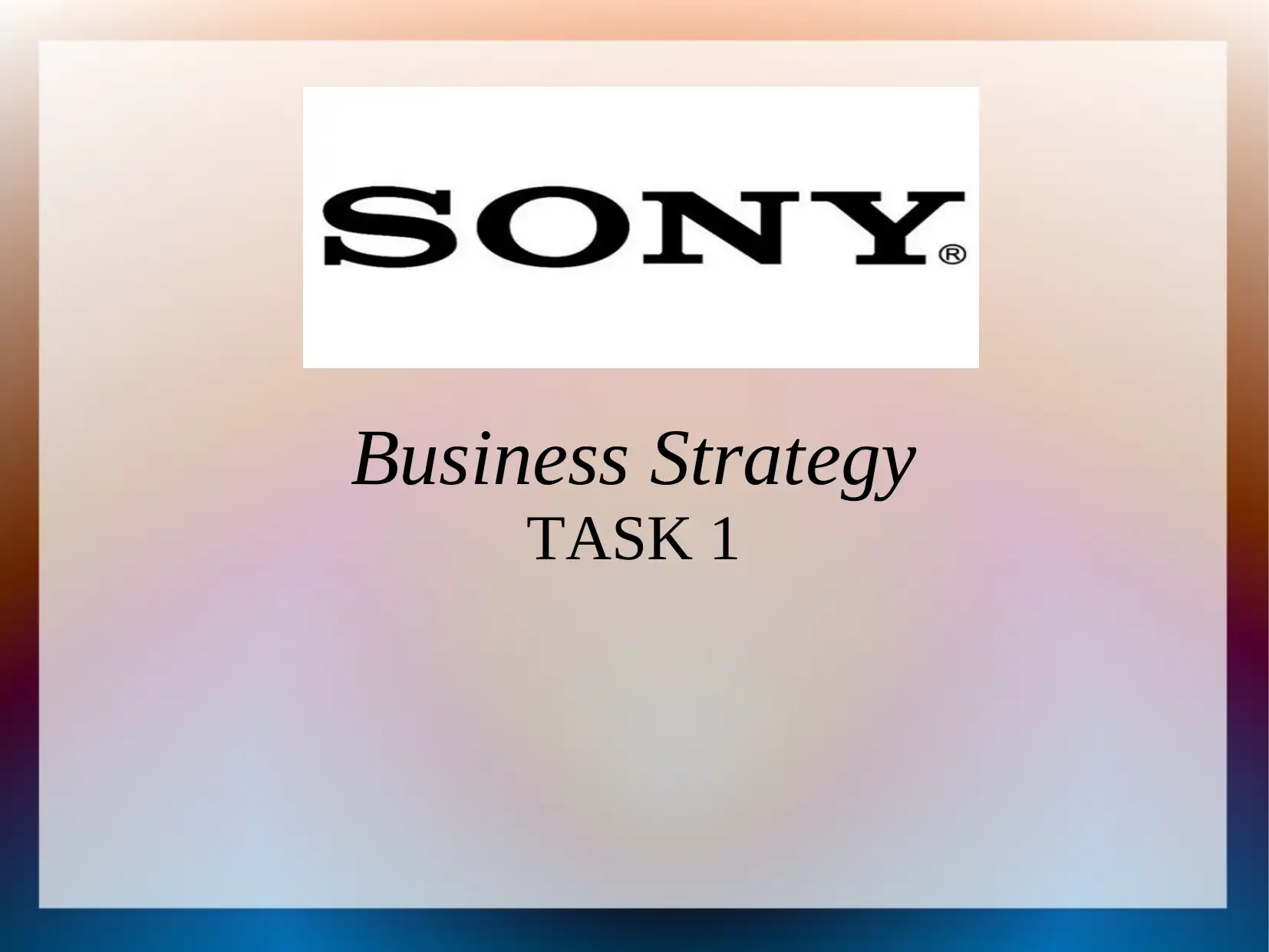
Business Strategy
TASK 1
TASK 1
Secure Best Marks with AI Grader
Need help grading? Try our AI Grader for instant feedback on your assignments.
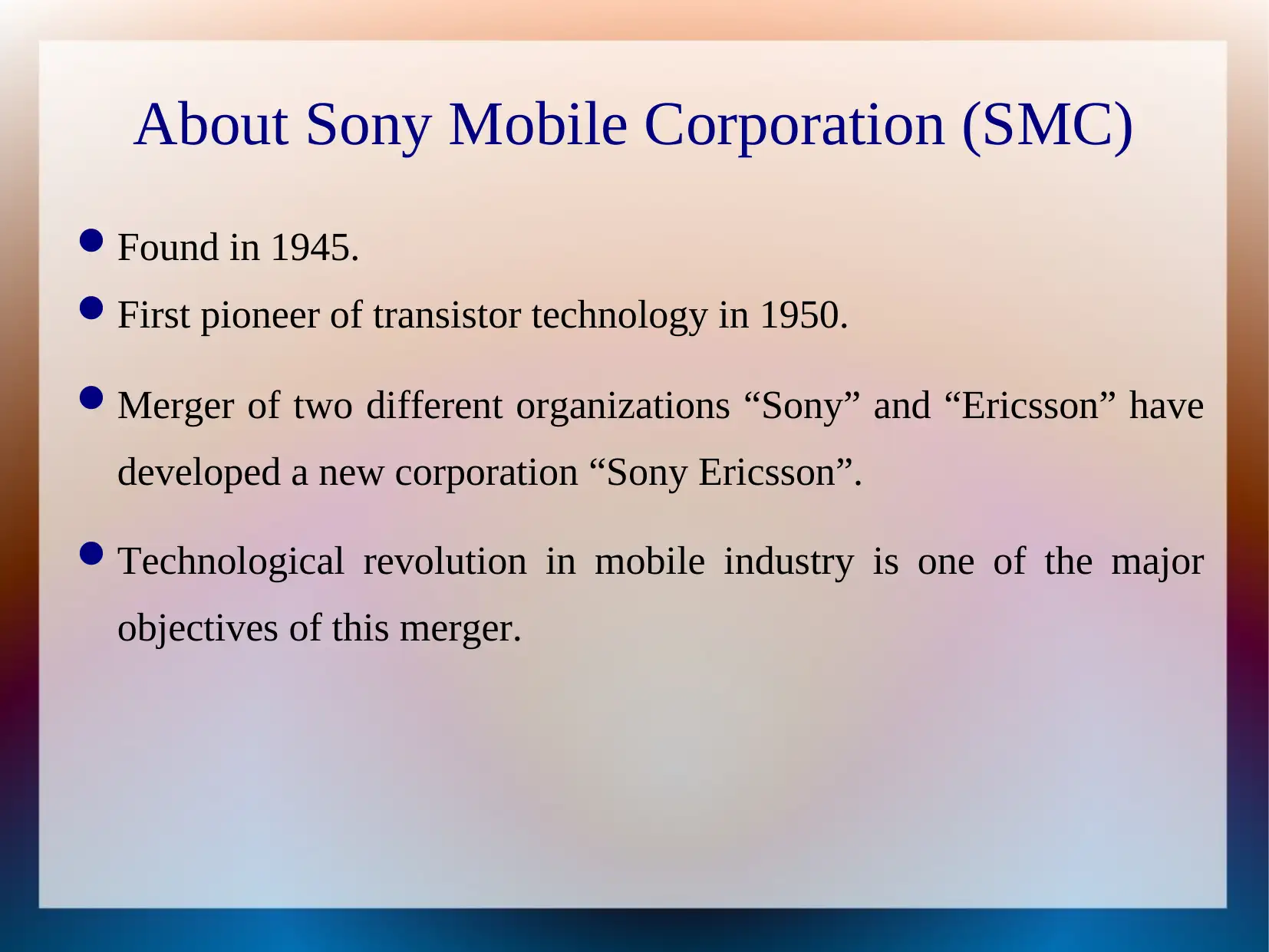
About Sony Mobile Corporation (SMC)
Found in 1945.
First pioneer of transistor technology in 1950.
Merger of two different organizations “Sony” and “Ericsson” have
developed a new corporation “Sony Ericsson”.
Technological revolution in mobile industry is one of the major
objectives of this merger.
Found in 1945.
First pioneer of transistor technology in 1950.
Merger of two different organizations “Sony” and “Ericsson” have
developed a new corporation “Sony Ericsson”.
Technological revolution in mobile industry is one of the major
objectives of this merger.
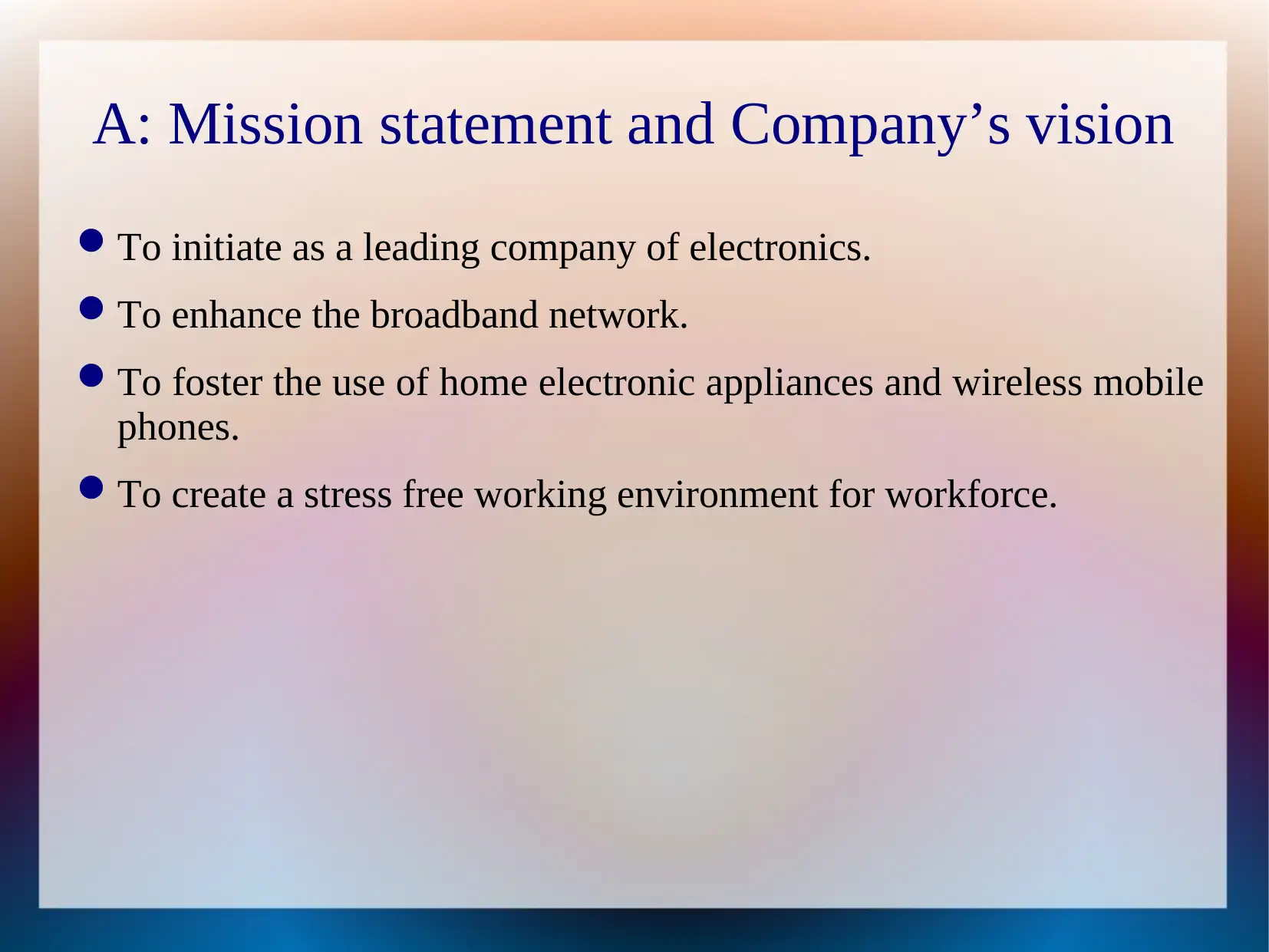
A: Mission statement and Company’s vision
To initiate as a leading company of electronics.
To enhance the broadband network.
To foster the use of home electronic appliances and wireless mobile
phones.
To create a stress free working environment for workforce.
To initiate as a leading company of electronics.
To enhance the broadband network.
To foster the use of home electronic appliances and wireless mobile
phones.
To create a stress free working environment for workforce.

Core Competencies
Technological advantage enables to create a unique image.
Provide customers with the latest demand.
Differentiation strategy for developing core ability.
To provide the products after research and development to
customers.
To position itself different from competitors.
Technological advantage enables to create a unique image.
Provide customers with the latest demand.
Differentiation strategy for developing core ability.
To provide the products after research and development to
customers.
To position itself different from competitors.
Secure Best Marks with AI Grader
Need help grading? Try our AI Grader for instant feedback on your assignments.
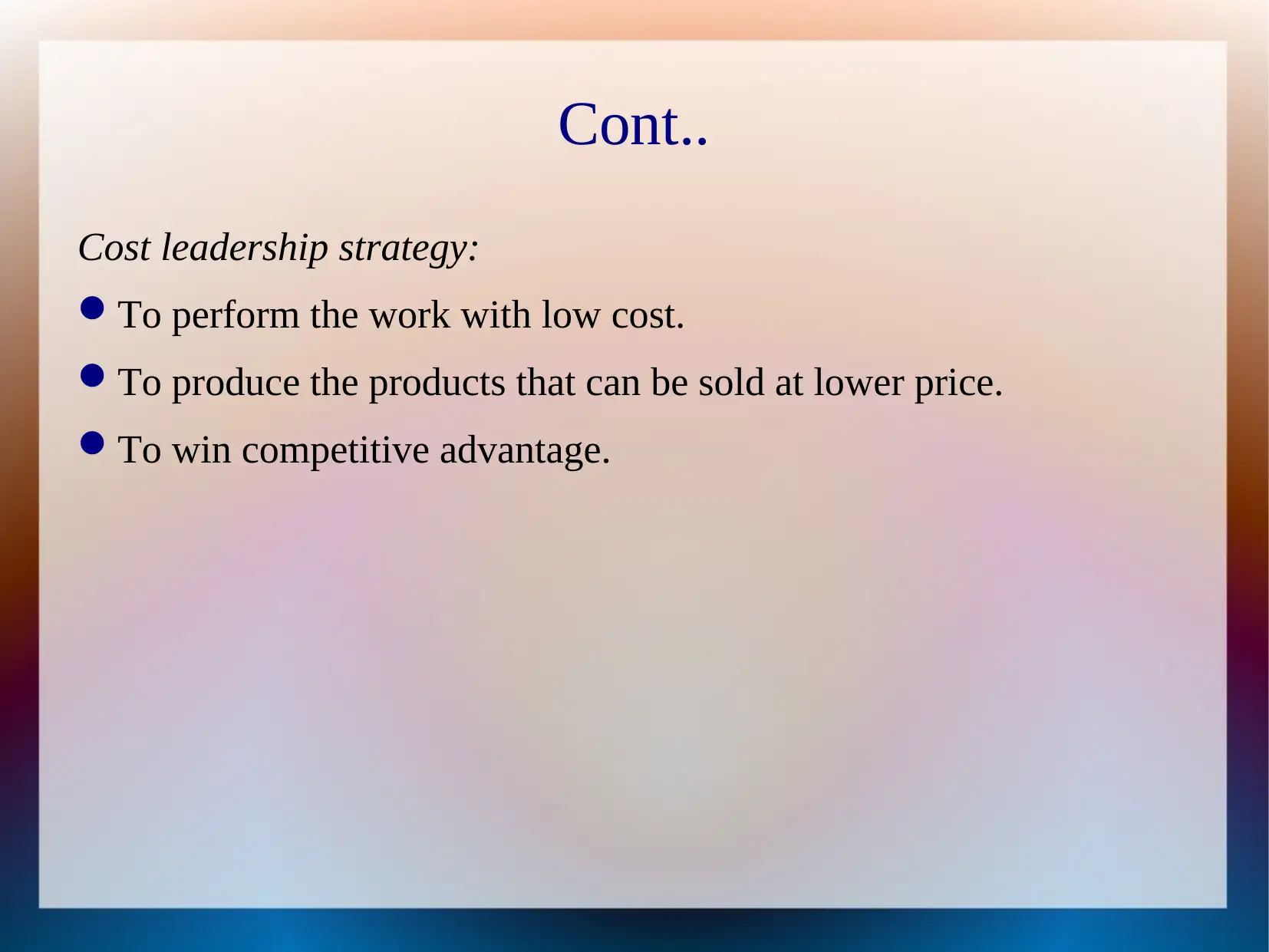
Cont..
Cost leadership strategy:
To perform the work with low cost.
To produce the products that can be sold at lower price.
To win competitive advantage.
Cost leadership strategy:
To perform the work with low cost.
To produce the products that can be sold at lower price.
To win competitive advantage.
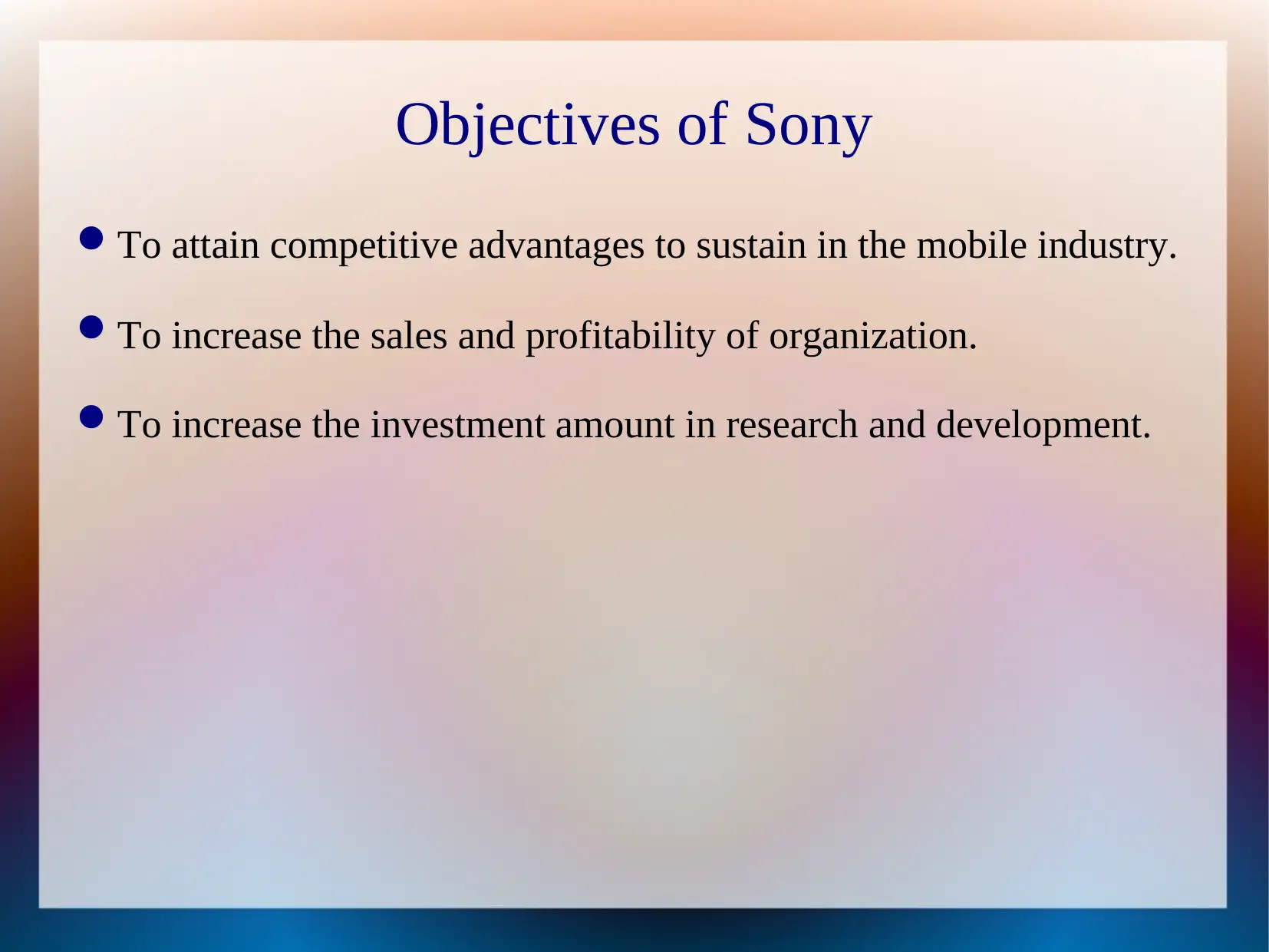
Objectives of Sony
To attain competitive advantages to sustain in the mobile industry.
To increase the sales and profitability of organization.
To increase the investment amount in research and development.
To attain competitive advantages to sustain in the mobile industry.
To increase the sales and profitability of organization.
To increase the investment amount in research and development.
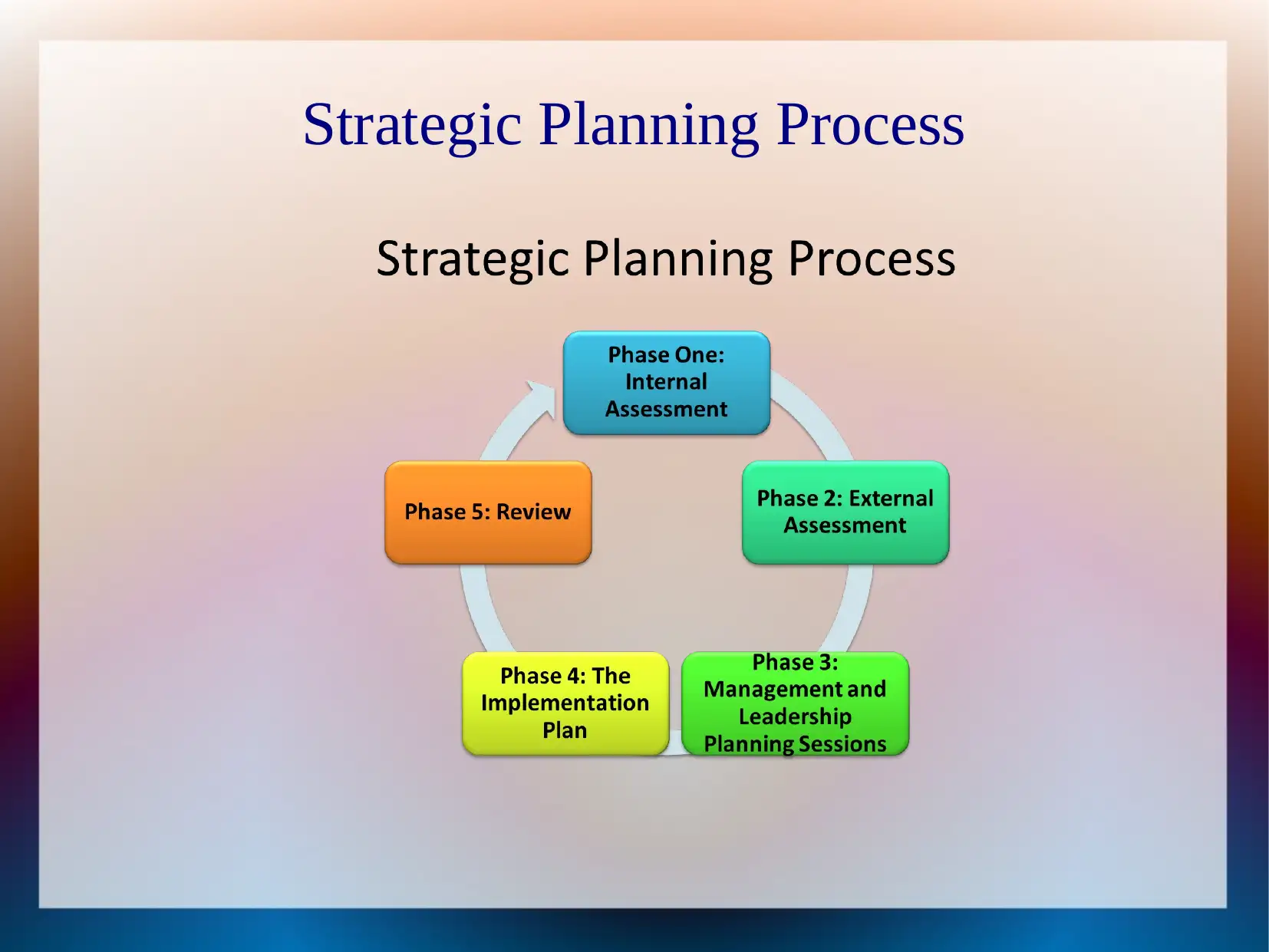
Strategic Planning Process
Paraphrase This Document
Need a fresh take? Get an instant paraphrase of this document with our AI Paraphraser
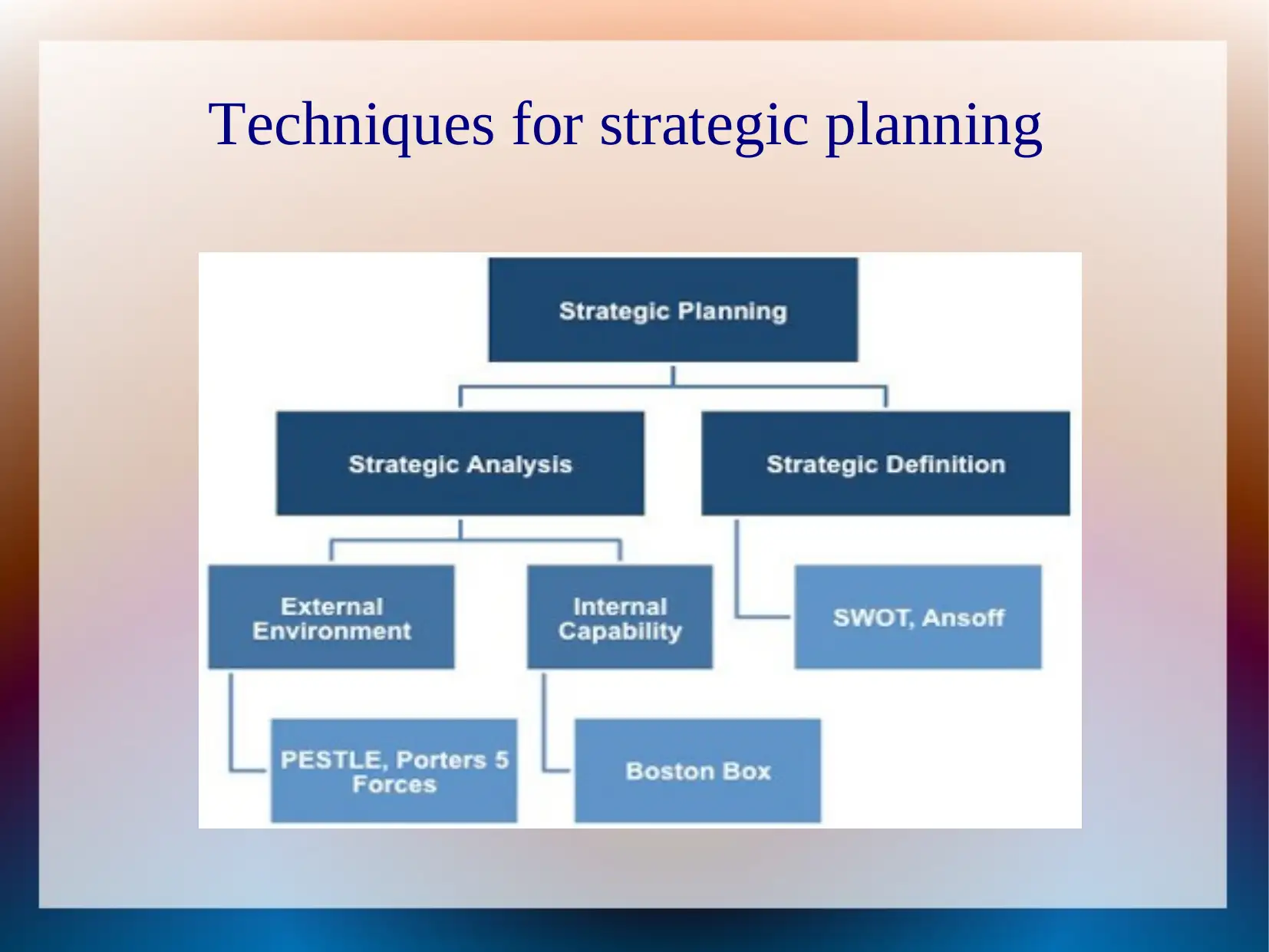
Techniques for strategic planning
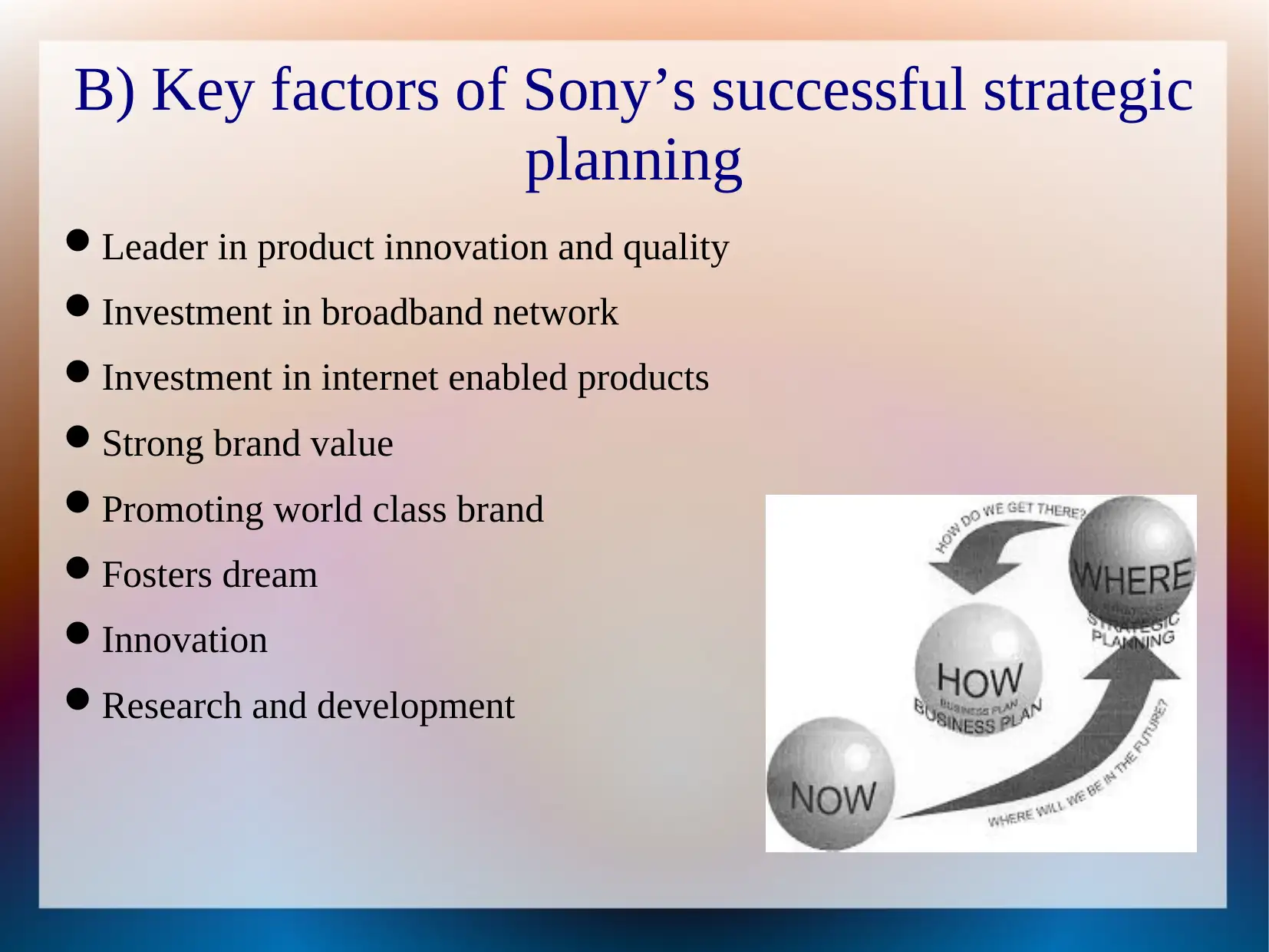
B) Key factors of Sony’s successful strategic
planning
Leader in product innovation and quality
Investment in broadband network
Investment in internet enabled products
Strong brand value
Promoting world class brand
Fosters dream
Innovation
Research and development
planning
Leader in product innovation and quality
Investment in broadband network
Investment in internet enabled products
Strong brand value
Promoting world class brand
Fosters dream
Innovation
Research and development
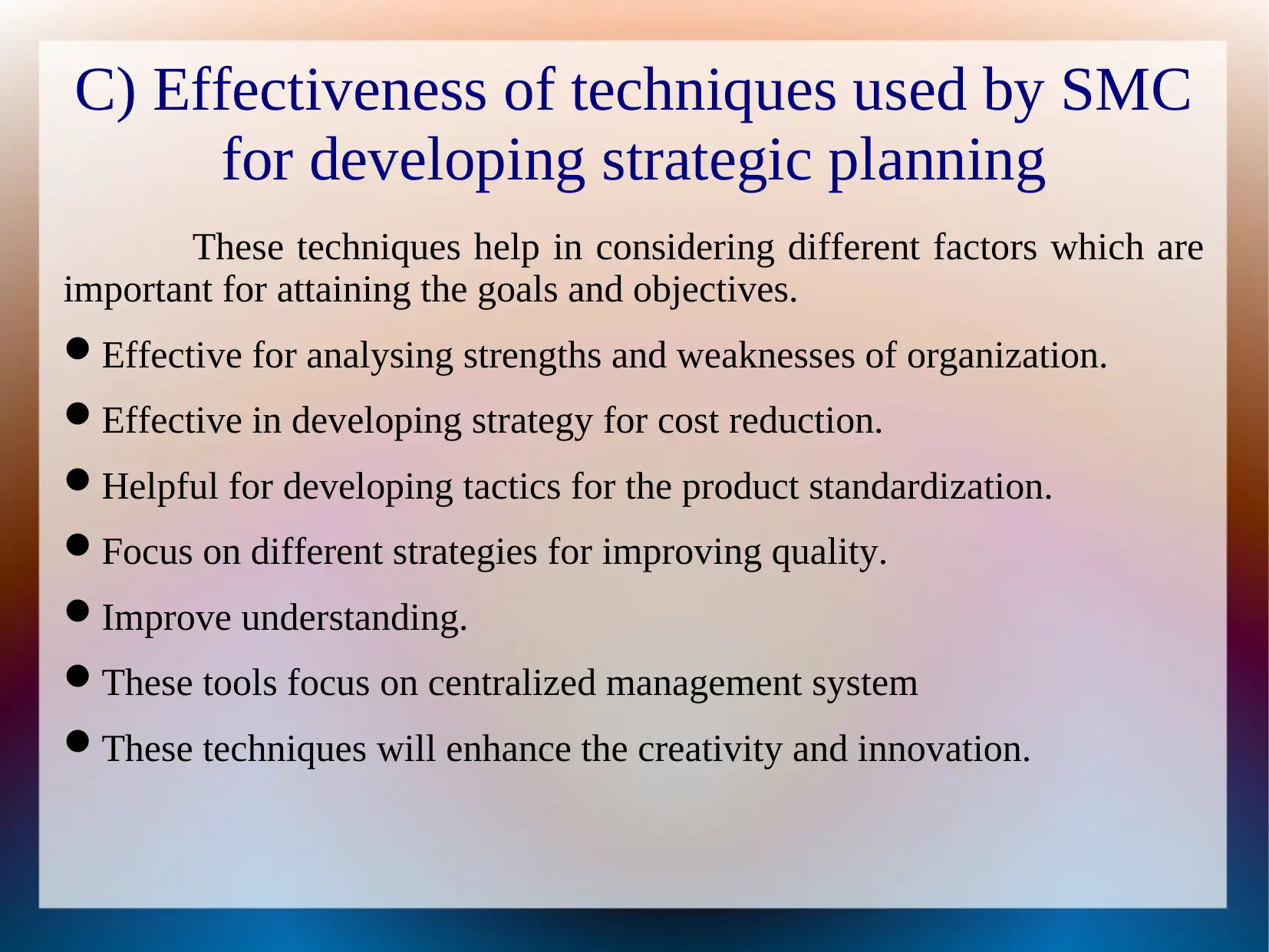
C) Effectiveness of techniques used by SMC
for developing strategic planning
These techniques help in considering different factors which are
important for attaining the goals and objectives.
Effective for analysing strengths and weaknesses of organization.
Effective in developing strategy for cost reduction.
Helpful for developing tactics for the product standardization.
Focus on different strategies for improving quality.
Improve understanding.
These tools focus on centralized management system
These techniques will enhance the creativity and innovation.
for developing strategic planning
These techniques help in considering different factors which are
important for attaining the goals and objectives.
Effective for analysing strengths and weaknesses of organization.
Effective in developing strategy for cost reduction.
Helpful for developing tactics for the product standardization.
Focus on different strategies for improving quality.
Improve understanding.
These tools focus on centralized management system
These techniques will enhance the creativity and innovation.
Secure Best Marks with AI Grader
Need help grading? Try our AI Grader for instant feedback on your assignments.
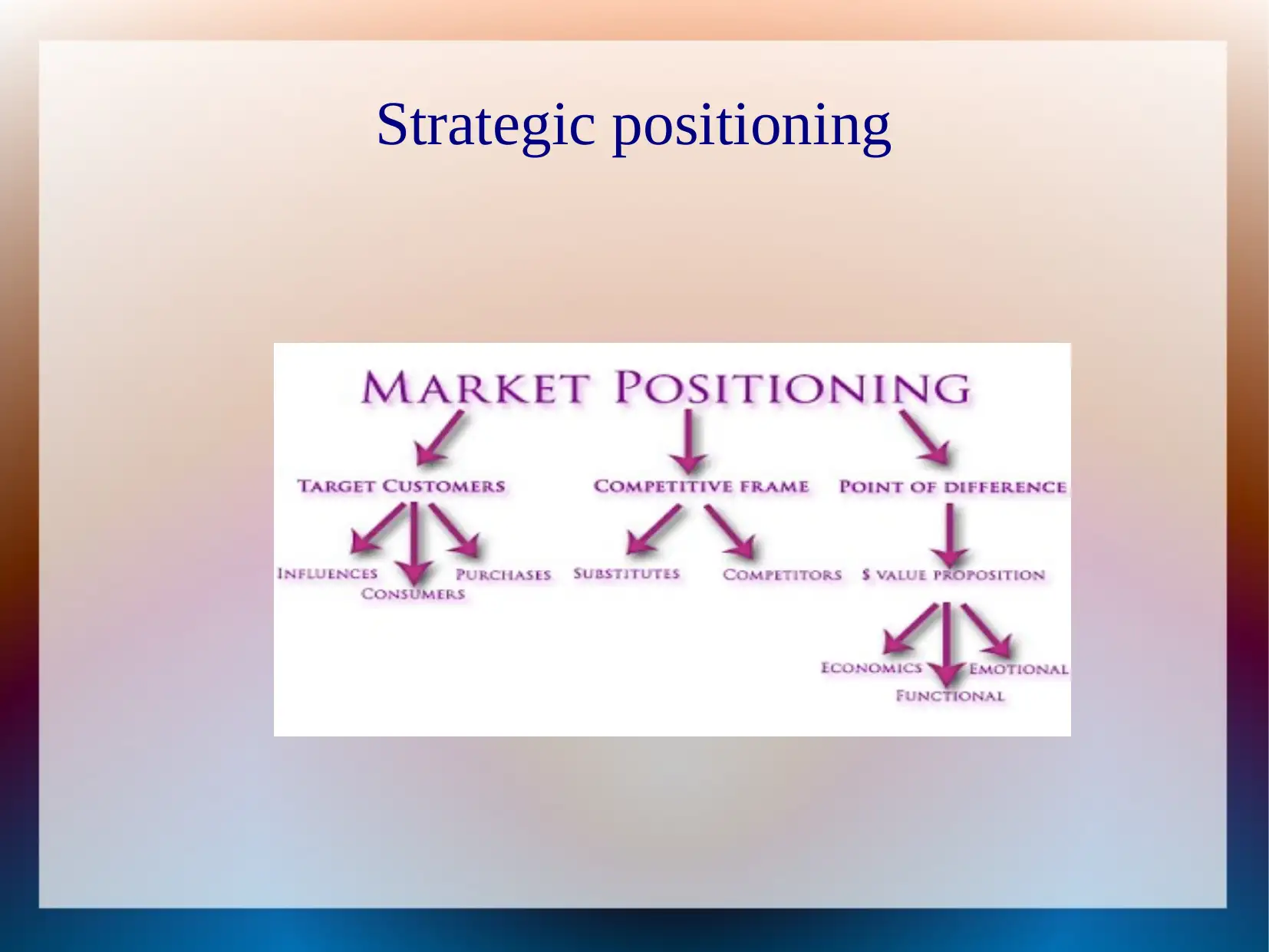
Strategic positioning
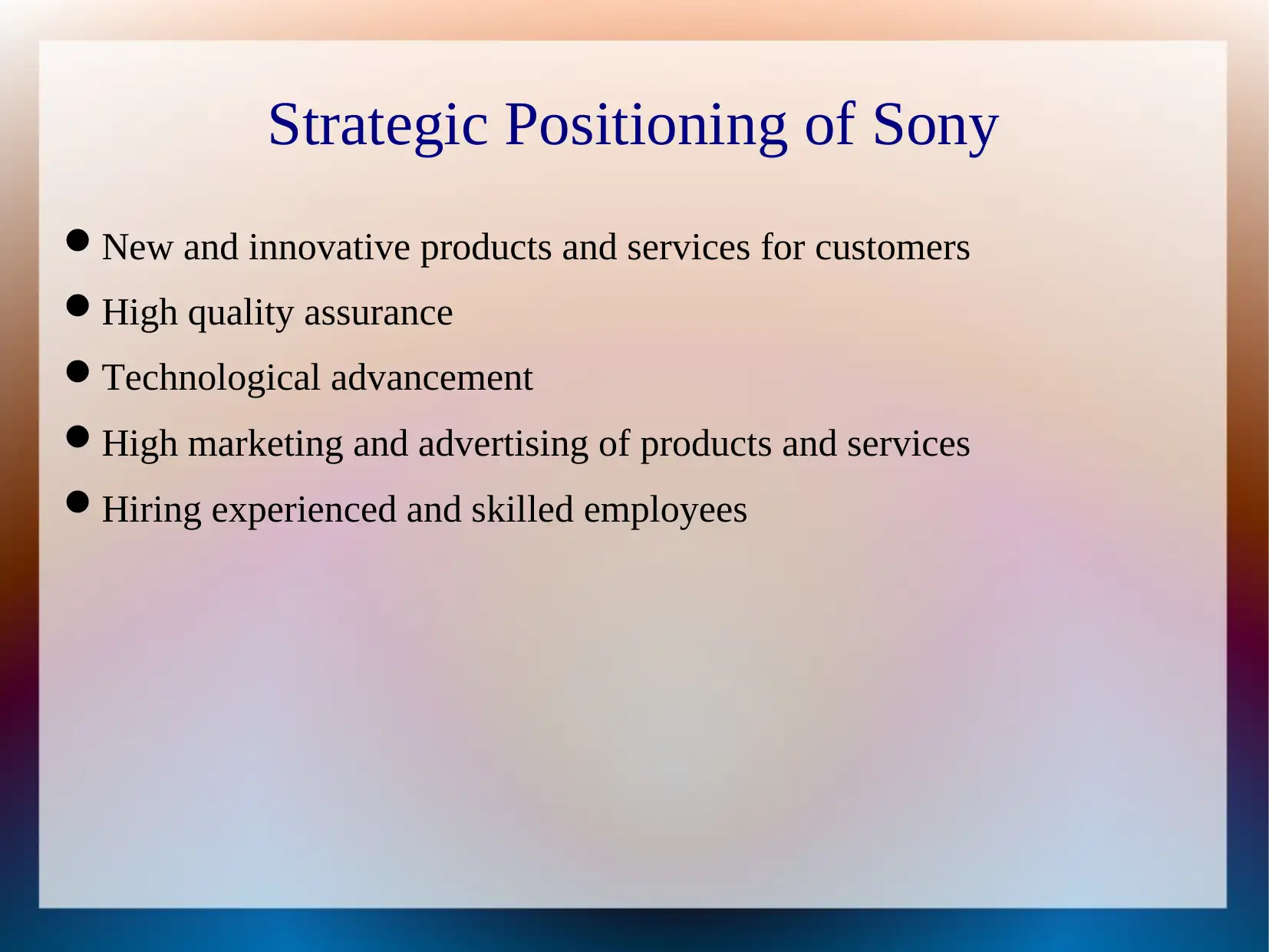
Strategic Positioning of Sony
New and innovative products and services for customers
High quality assurance
Technological advancement
High marketing and advertising of products and services
Hiring experienced and skilled employees
New and innovative products and services for customers
High quality assurance
Technological advancement
High marketing and advertising of products and services
Hiring experienced and skilled employees
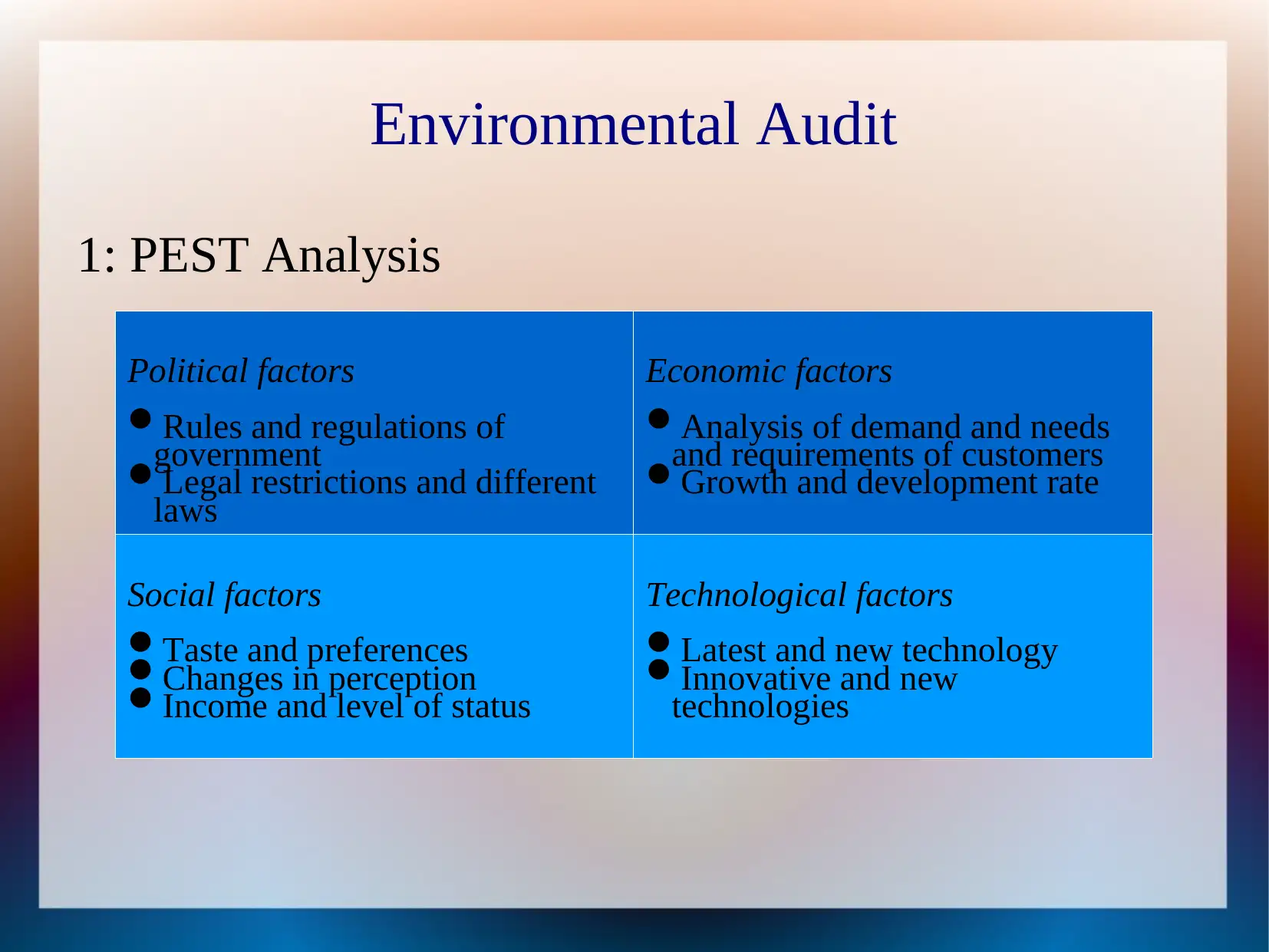
Environmental Audit
1: PEST Analysis
Political factors
Rules and regulations of
government
Legal restrictions and different
laws
Economic factors
Analysis of demand and needs
and requirements of customers
Growth and development rate
Social factors
Taste and preferences
Changes in perception
Income and level of status
Technological factors
Latest and new technology
Innovative and new
technologies
1: PEST Analysis
Political factors
Rules and regulations of
government
Legal restrictions and different
laws
Economic factors
Analysis of demand and needs
and requirements of customers
Growth and development rate
Social factors
Taste and preferences
Changes in perception
Income and level of status
Technological factors
Latest and new technology
Innovative and new
technologies
Paraphrase This Document
Need a fresh take? Get an instant paraphrase of this document with our AI Paraphraser
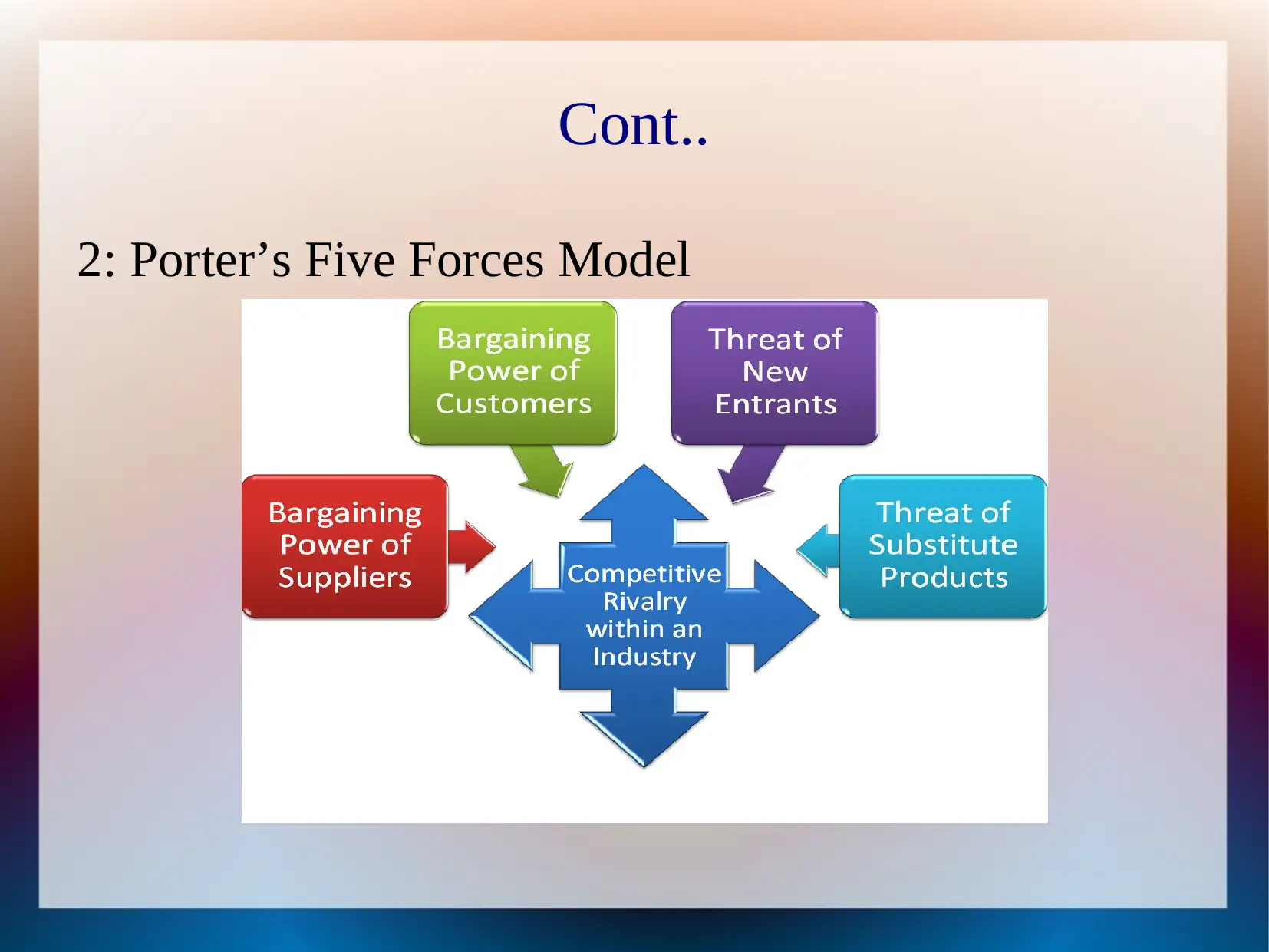
Cont..
2: Porter’s Five Forces Model
2: Porter’s Five Forces Model
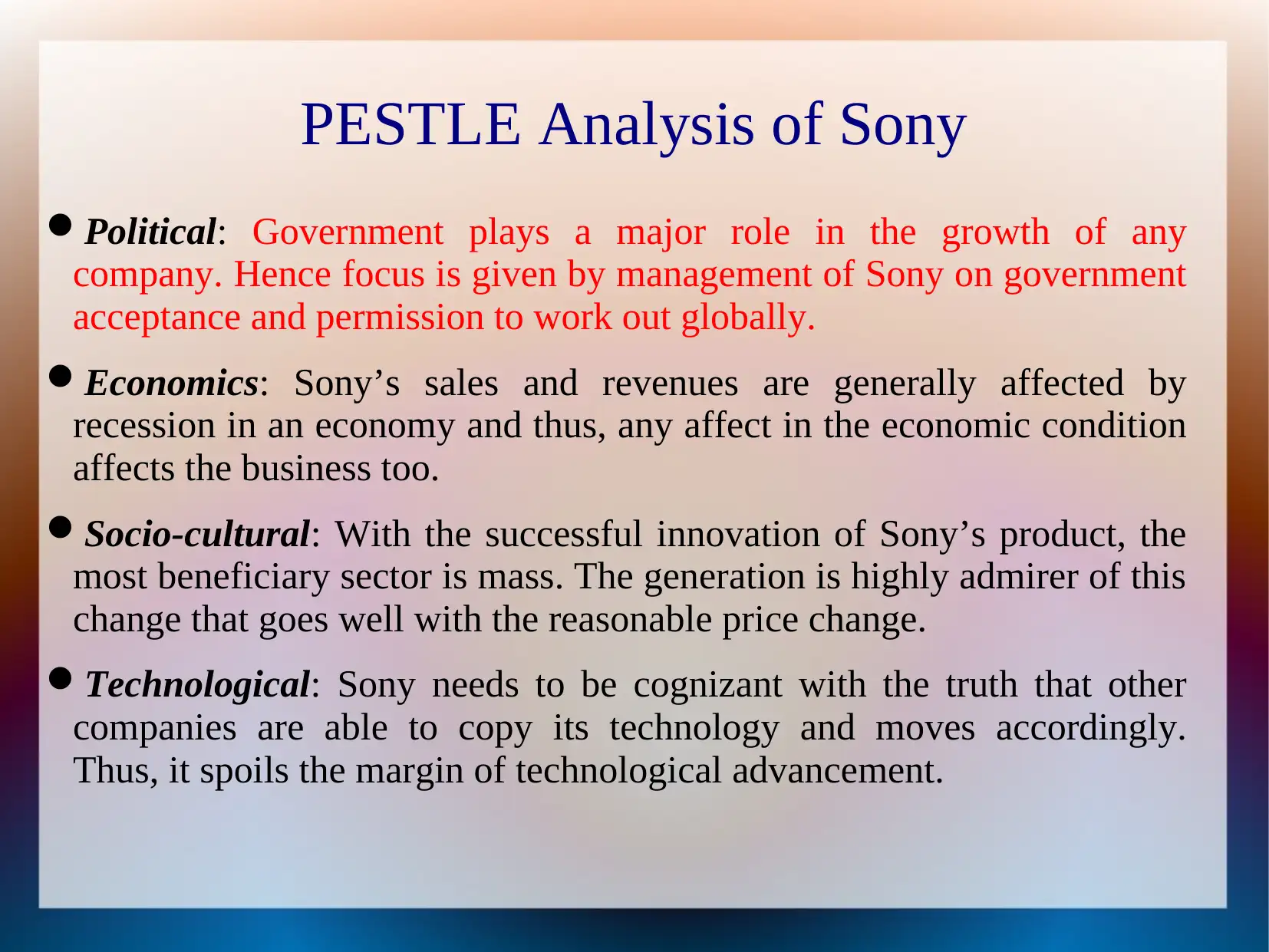
PESTLE Analysis of Sony
Political: Government plays a major role in the growth of any
company. Hence focus is given by management of Sony on government
acceptance and permission to work out globally.
Economics: Sony’s sales and revenues are generally affected by
recession in an economy and thus, any affect in the economic condition
affects the business too.
Socio-cultural: With the successful innovation of Sony’s product, the
most beneficiary sector is mass. The generation is highly admirer of this
change that goes well with the reasonable price change.
Technological: Sony needs to be cognizant with the truth that other
companies are able to copy its technology and moves accordingly.
Thus, it spoils the margin of technological advancement.
Political: Government plays a major role in the growth of any
company. Hence focus is given by management of Sony on government
acceptance and permission to work out globally.
Economics: Sony’s sales and revenues are generally affected by
recession in an economy and thus, any affect in the economic condition
affects the business too.
Socio-cultural: With the successful innovation of Sony’s product, the
most beneficiary sector is mass. The generation is highly admirer of this
change that goes well with the reasonable price change.
Technological: Sony needs to be cognizant with the truth that other
companies are able to copy its technology and moves accordingly.
Thus, it spoils the margin of technological advancement.
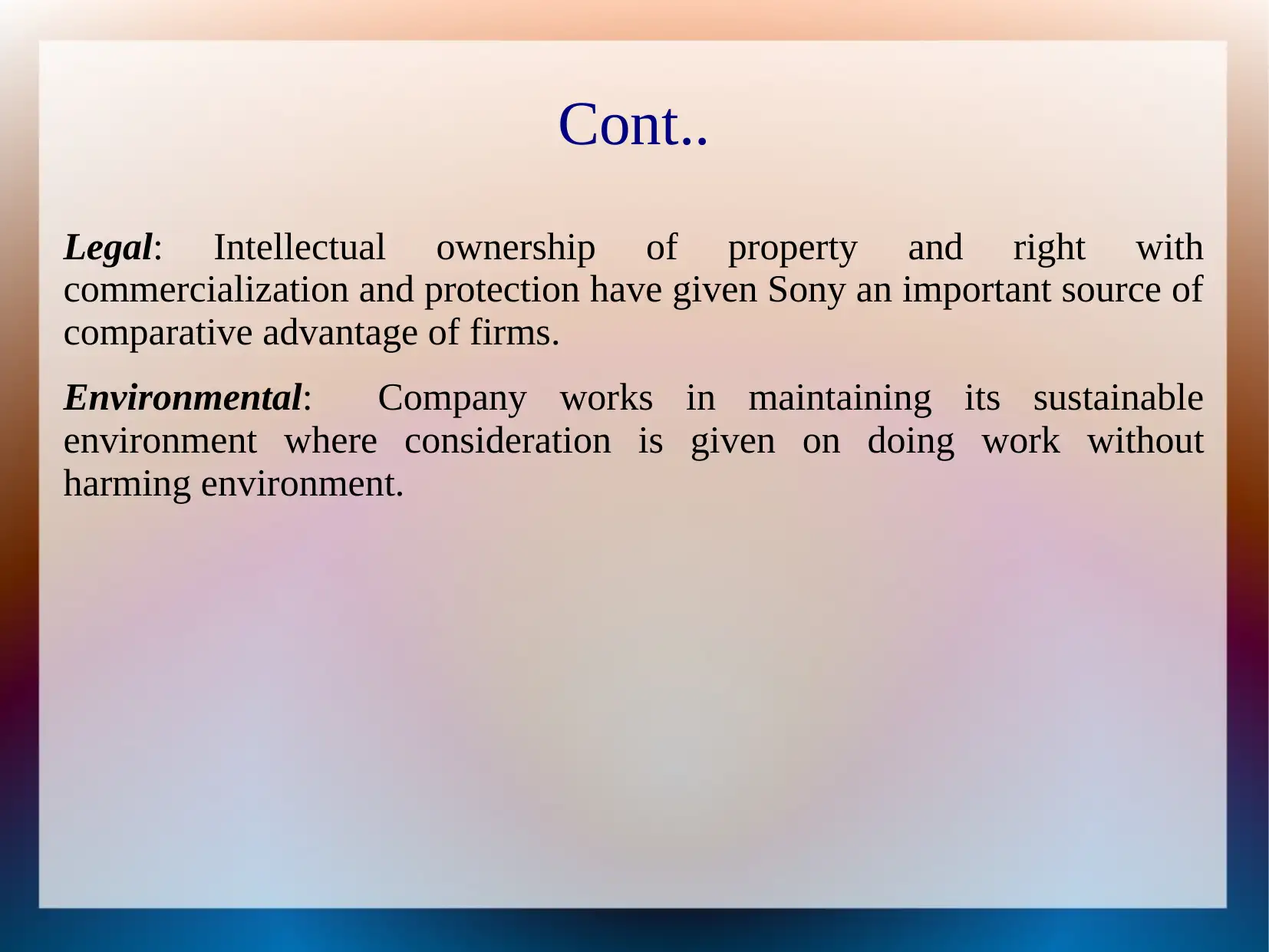
Cont..
Legal: Intellectual ownership of property and right with
commercialization and protection have given Sony an important source of
comparative advantage of firms.
Environmental: Company works in maintaining its sustainable
environment where consideration is given on doing work without
harming environment.
Legal: Intellectual ownership of property and right with
commercialization and protection have given Sony an important source of
comparative advantage of firms.
Environmental: Company works in maintaining its sustainable
environment where consideration is given on doing work without
harming environment.
Secure Best Marks with AI Grader
Need help grading? Try our AI Grader for instant feedback on your assignments.
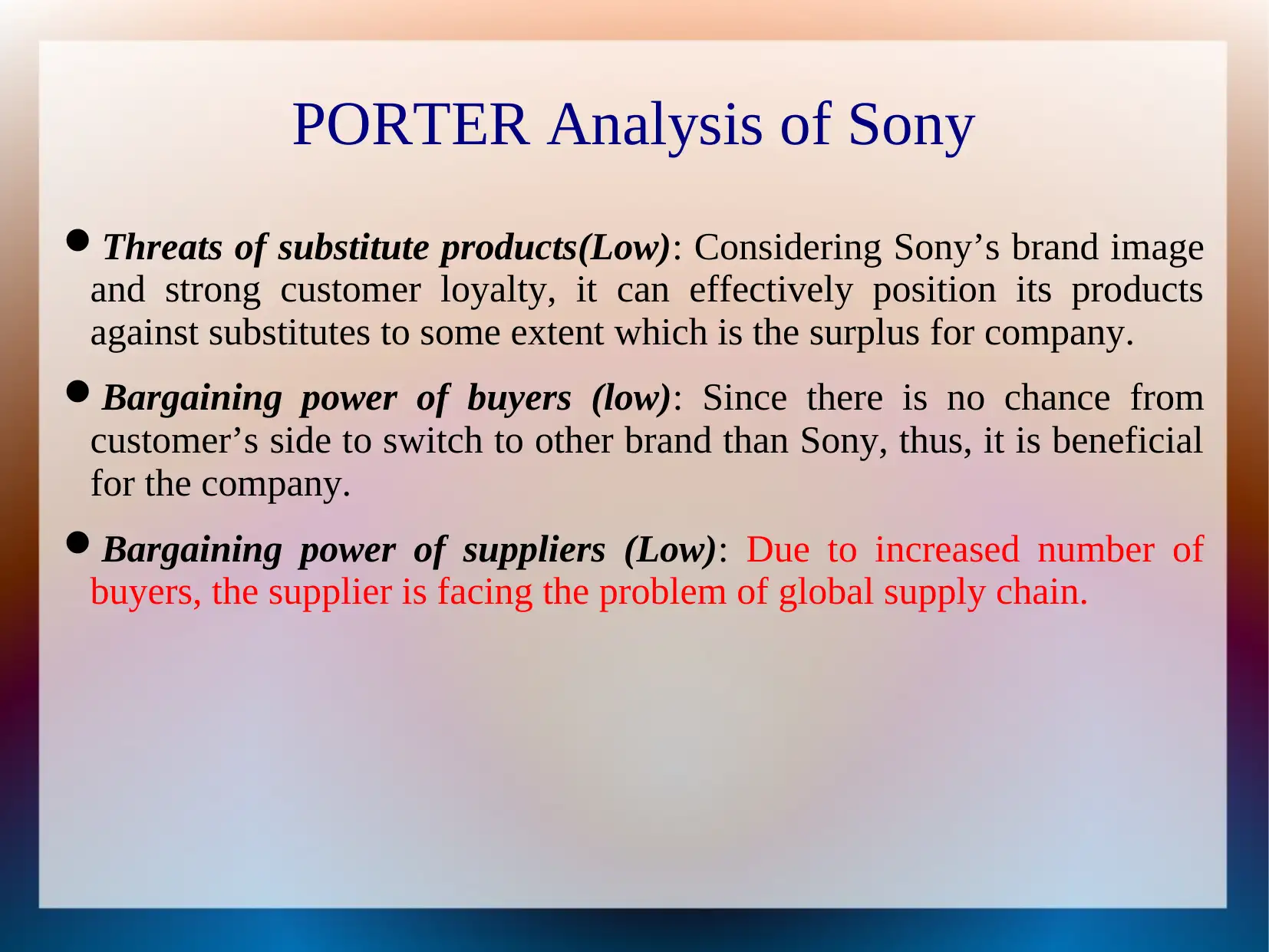
PORTER Analysis of Sony
Threats of substitute products(Low): Considering Sony’s brand image
and strong customer loyalty, it can effectively position its products
against substitutes to some extent which is the surplus for company.
Bargaining power of buyers (low): Since there is no chance from
customer’s side to switch to other brand than Sony, thus, it is beneficial
for the company.
Bargaining power of suppliers (Low): Due to increased number of
buyers, the supplier is facing the problem of global supply chain.
Threats of substitute products(Low): Considering Sony’s brand image
and strong customer loyalty, it can effectively position its products
against substitutes to some extent which is the surplus for company.
Bargaining power of buyers (low): Since there is no chance from
customer’s side to switch to other brand than Sony, thus, it is beneficial
for the company.
Bargaining power of suppliers (Low): Due to increased number of
buyers, the supplier is facing the problem of global supply chain.
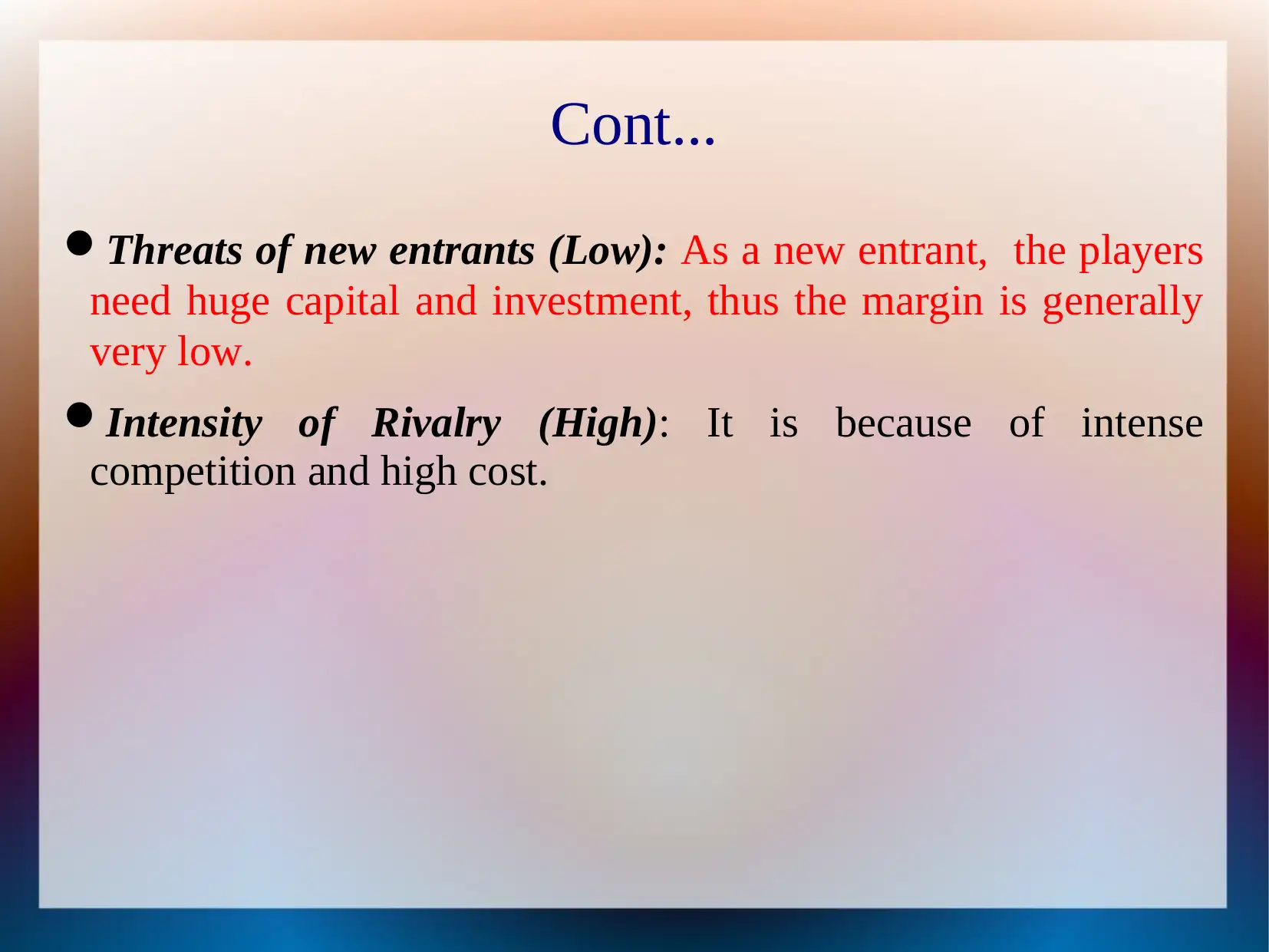
Cont...
Threats of new entrants (Low): As a new entrant, the players
need huge capital and investment, thus the margin is generally
very low.
Intensity of Rivalry (High): It is because of intense
competition and high cost.
Threats of new entrants (Low): As a new entrant, the players
need huge capital and investment, thus the margin is generally
very low.
Intensity of Rivalry (High): It is because of intense
competition and high cost.
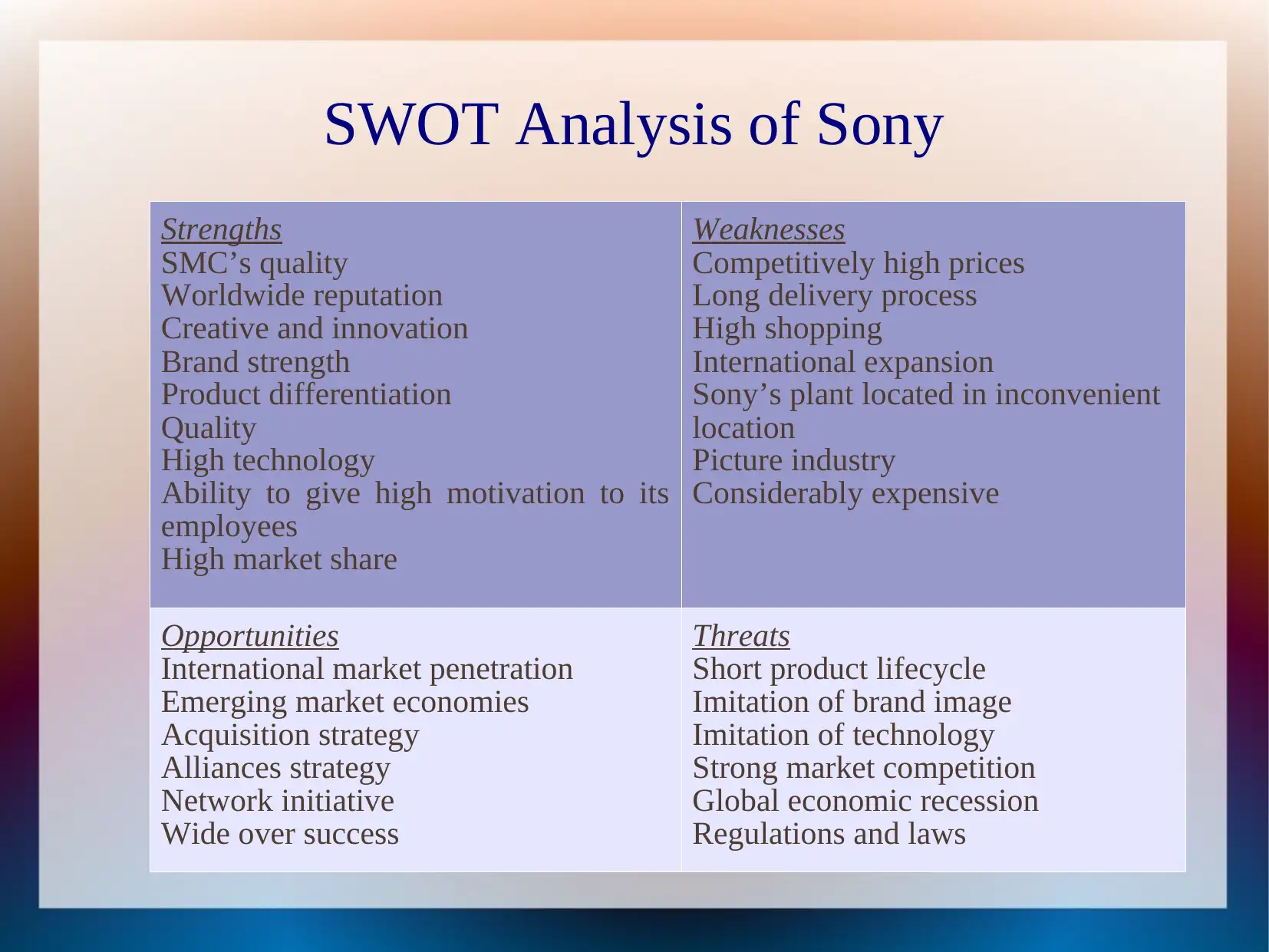
SWOT Analysis of Sony
Strengths
SMC’s quality
Worldwide reputation
Creative and innovation
Brand strength
Product differentiation
Quality
High technology
Ability to give high motivation to its
employees
High market share
Weaknesses
Competitively high prices
Long delivery process
High shopping
International expansion
Sony’s plant located in inconvenient
location
Picture industry
Considerably expensive
Opportunities
International market penetration
Emerging market economies
Acquisition strategy
Alliances strategy
Network initiative
Wide over success
Threats
Short product lifecycle
Imitation of brand image
Imitation of technology
Strong market competition
Global economic recession
Regulations and laws
Strengths
SMC’s quality
Worldwide reputation
Creative and innovation
Brand strength
Product differentiation
Quality
High technology
Ability to give high motivation to its
employees
High market share
Weaknesses
Competitively high prices
Long delivery process
High shopping
International expansion
Sony’s plant located in inconvenient
location
Picture industry
Considerably expensive
Opportunities
International market penetration
Emerging market economies
Acquisition strategy
Alliances strategy
Network initiative
Wide over success
Threats
Short product lifecycle
Imitation of brand image
Imitation of technology
Strong market competition
Global economic recession
Regulations and laws
Paraphrase This Document
Need a fresh take? Get an instant paraphrase of this document with our AI Paraphraser

F) Stakeholder Analysis
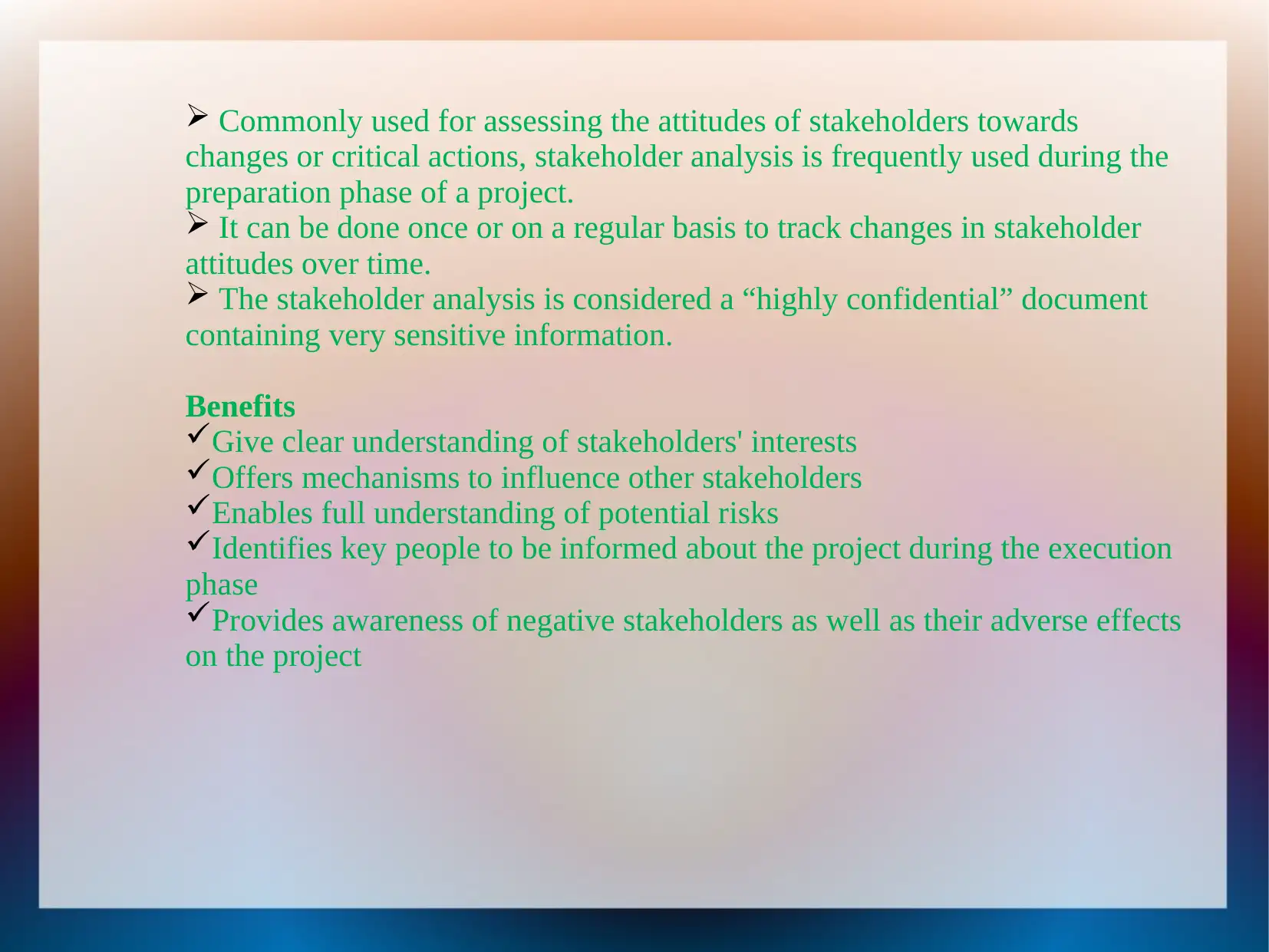
Commonly used for assessing the attitudes of stakeholders towards
changes or critical actions, stakeholder analysis is frequently used during the
preparation phase of a project.
It can be done once or on a regular basis to track changes in stakeholder
attitudes over time.
The stakeholder analysis is considered a “highly confidential” document
containing very sensitive information.
Benefits
Give clear understanding of stakeholders' interests
Offers mechanisms to influence other stakeholders
Enables full understanding of potential risks
Identifies key people to be informed about the project during the execution
phase
Provides awareness of negative stakeholders as well as their adverse effects
on the project
changes or critical actions, stakeholder analysis is frequently used during the
preparation phase of a project.
It can be done once or on a regular basis to track changes in stakeholder
attitudes over time.
The stakeholder analysis is considered a “highly confidential” document
containing very sensitive information.
Benefits
Give clear understanding of stakeholders' interests
Offers mechanisms to influence other stakeholders
Enables full understanding of potential risks
Identifies key people to be informed about the project during the execution
phase
Provides awareness of negative stakeholders as well as their adverse effects
on the project
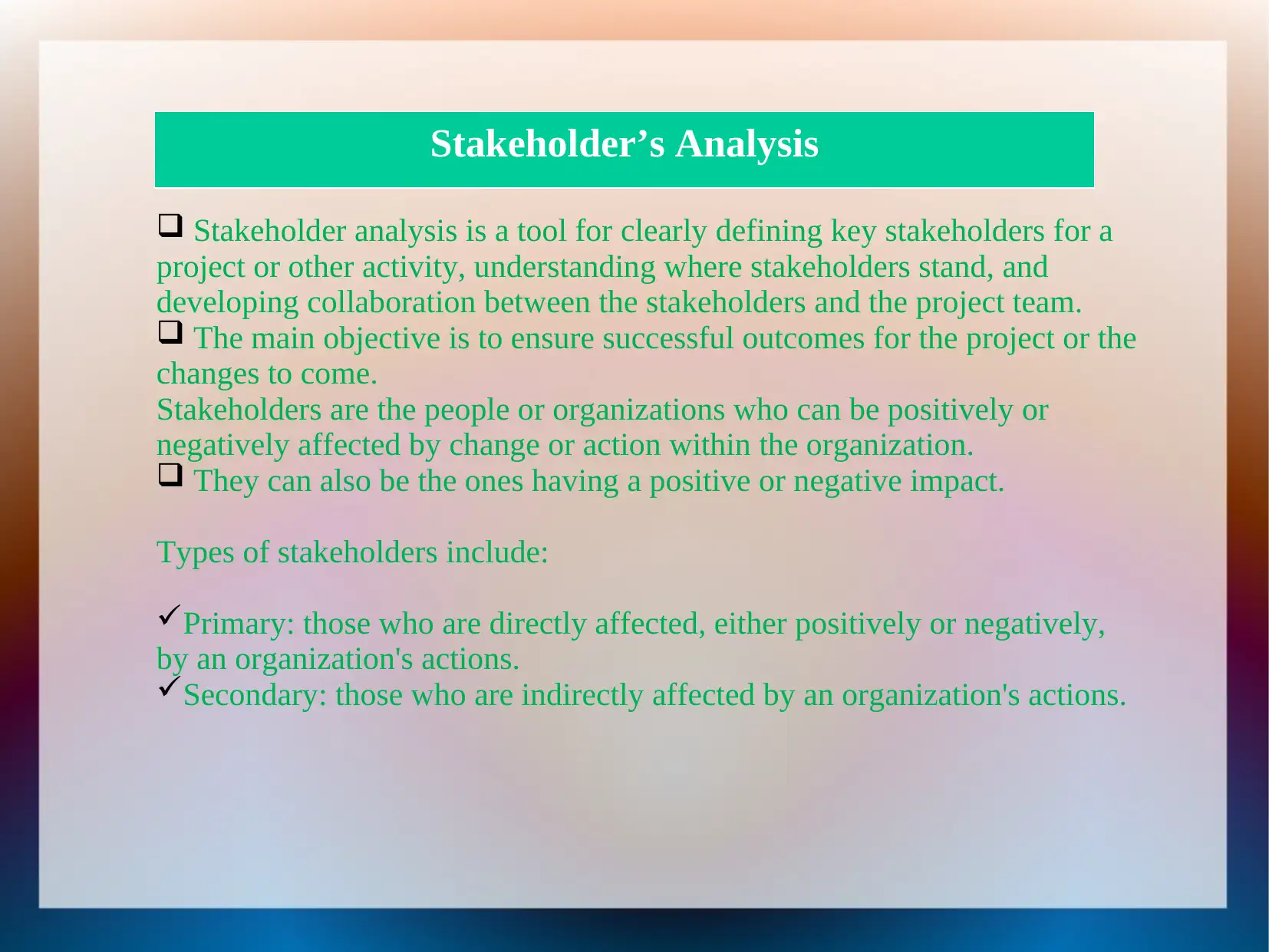
Stakeholder analysis is a tool for clearly defining key stakeholders for a
project or other activity, understanding where stakeholders stand, and
developing collaboration between the stakeholders and the project team.
The main objective is to ensure successful outcomes for the project or the
changes to come.
Stakeholders are the people or organizations who can be positively or
negatively affected by change or action within the organization.
They can also be the ones having a positive or negative impact.
Types of stakeholders include:
Primary: those who are directly affected, either positively or negatively,
by an organization's actions.
Secondary: those who are indirectly affected by an organization's actions.
Stakeholder’s Analysis
project or other activity, understanding where stakeholders stand, and
developing collaboration between the stakeholders and the project team.
The main objective is to ensure successful outcomes for the project or the
changes to come.
Stakeholders are the people or organizations who can be positively or
negatively affected by change or action within the organization.
They can also be the ones having a positive or negative impact.
Types of stakeholders include:
Primary: those who are directly affected, either positively or negatively,
by an organization's actions.
Secondary: those who are indirectly affected by an organization's actions.
Stakeholder’s Analysis
Secure Best Marks with AI Grader
Need help grading? Try our AI Grader for instant feedback on your assignments.
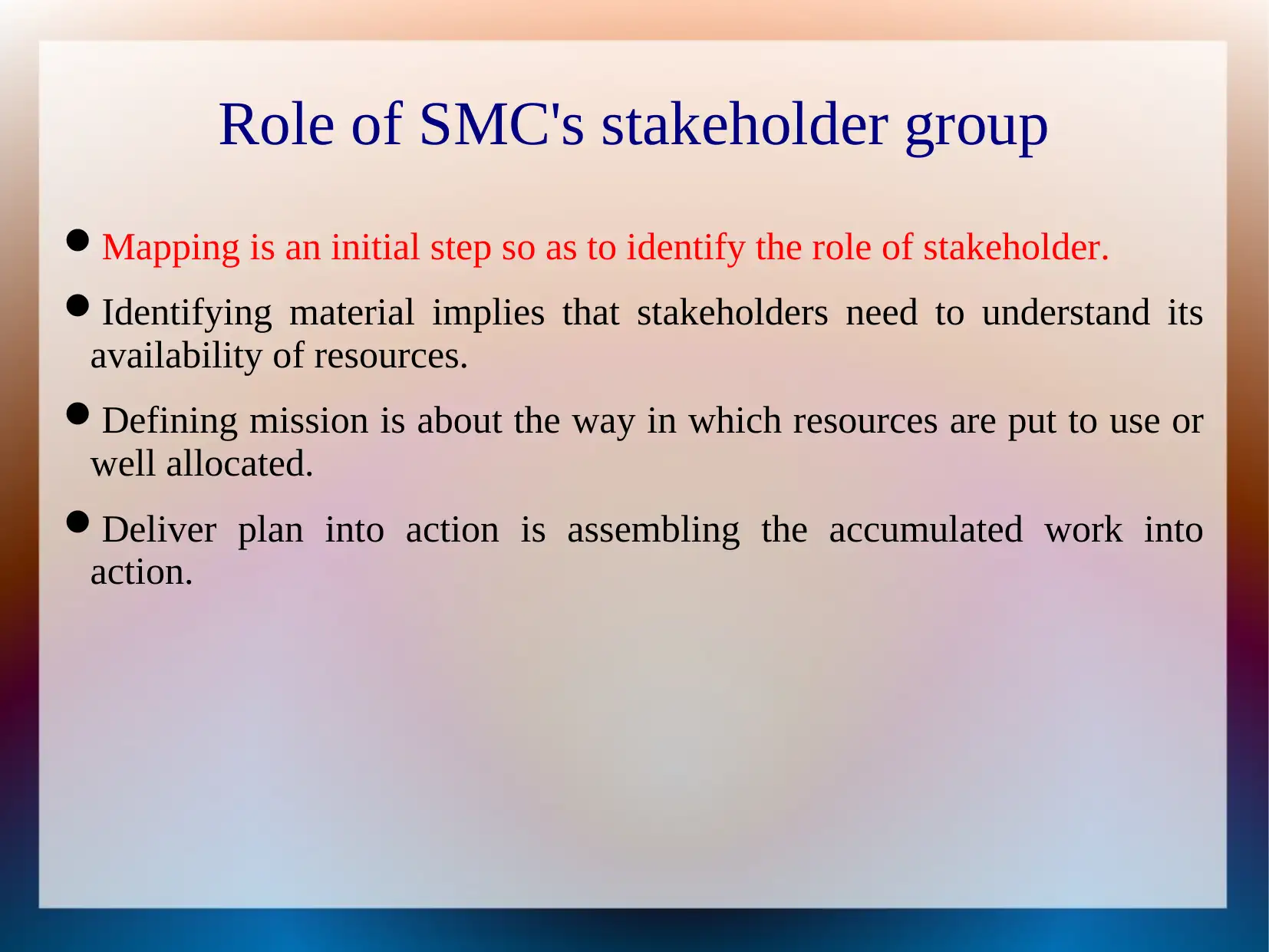
Role of SMC's stakeholder group
Mapping is an initial step so as to identify the role of stakeholder.
Identifying material implies that stakeholders need to understand its
availability of resources.
Defining mission is about the way in which resources are put to use or
well allocated.
Deliver plan into action is assembling the accumulated work into
action.
Mapping is an initial step so as to identify the role of stakeholder.
Identifying material implies that stakeholders need to understand its
availability of resources.
Defining mission is about the way in which resources are put to use or
well allocated.
Deliver plan into action is assembling the accumulated work into
action.
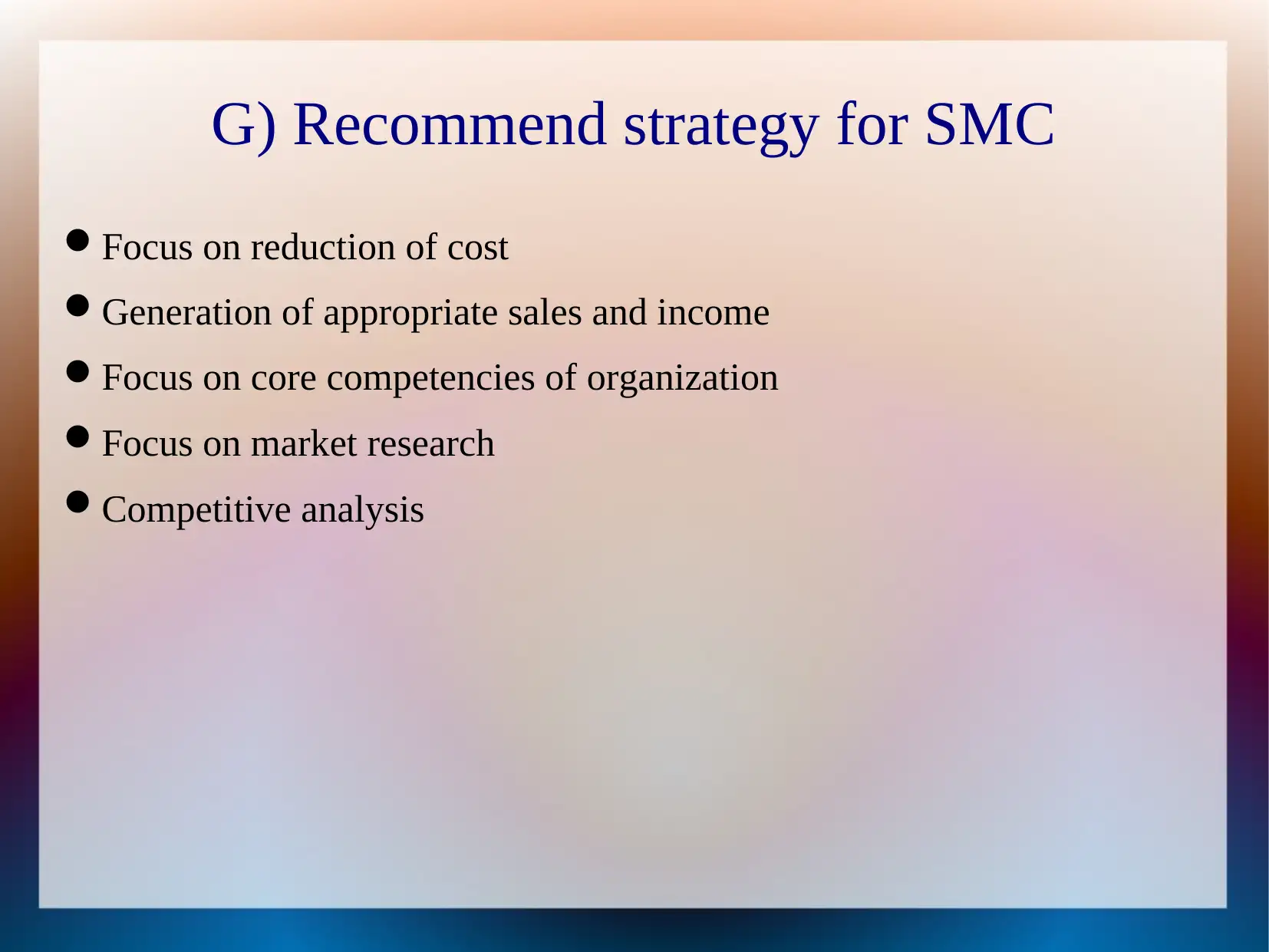
G) Recommend strategy for SMC
Focus on reduction of cost
Generation of appropriate sales and income
Focus on core competencies of organization
Focus on market research
Competitive analysis
Focus on reduction of cost
Generation of appropriate sales and income
Focus on core competencies of organization
Focus on market research
Competitive analysis

REFERENCES
Hensmans, M., Johnson, G. and Yip, G., 2013. Strategic Transformation: Changing
While Winning. Palgrave Macmillan Publication.
Singer, P. B. and et. al., 2007. Corporate real estate and competitive strategy.
Journal of Corporate Real Estate. 9(1). pp. 25–38.
Tiwari, R, Buse, S. and Herstatt, C., 2006. Mobile banking as business strategy:
Impact of mobile technologies on customer behaviour and its implications for
banks. 4. pp. 1935-1946.
Dameron, S. and Durand, T., 2013. Strategies for business schools in a multi‐polar
world. Education + Training. 55( 4/5). pp.323 – 335.
Holbeche, L., 2012. Aligning Human Resources and Business Strategy. Routledge.
Kim, C. W. and Mauborgne, R., 2013. Blue Ocean Strategy: How To Create
Uncontested Market Space And Make The Competition Irrelevant. Harvard Business
Press.
Hensmans, M., Johnson, G. and Yip, G., 2013. Strategic Transformation: Changing
While Winning. Palgrave Macmillan Publication.
Singer, P. B. and et. al., 2007. Corporate real estate and competitive strategy.
Journal of Corporate Real Estate. 9(1). pp. 25–38.
Tiwari, R, Buse, S. and Herstatt, C., 2006. Mobile banking as business strategy:
Impact of mobile technologies on customer behaviour and its implications for
banks. 4. pp. 1935-1946.
Dameron, S. and Durand, T., 2013. Strategies for business schools in a multi‐polar
world. Education + Training. 55( 4/5). pp.323 – 335.
Holbeche, L., 2012. Aligning Human Resources and Business Strategy. Routledge.
Kim, C. W. and Mauborgne, R., 2013. Blue Ocean Strategy: How To Create
Uncontested Market Space And Make The Competition Irrelevant. Harvard Business
Press.
Paraphrase This Document
Need a fresh take? Get an instant paraphrase of this document with our AI Paraphraser

Thank you
1 out of 26
Related Documents
Your All-in-One AI-Powered Toolkit for Academic Success.
+13062052269
info@desklib.com
Available 24*7 on WhatsApp / Email
![[object Object]](/_next/static/media/star-bottom.7253800d.svg)
Unlock your academic potential
© 2024 | Zucol Services PVT LTD | All rights reserved.





